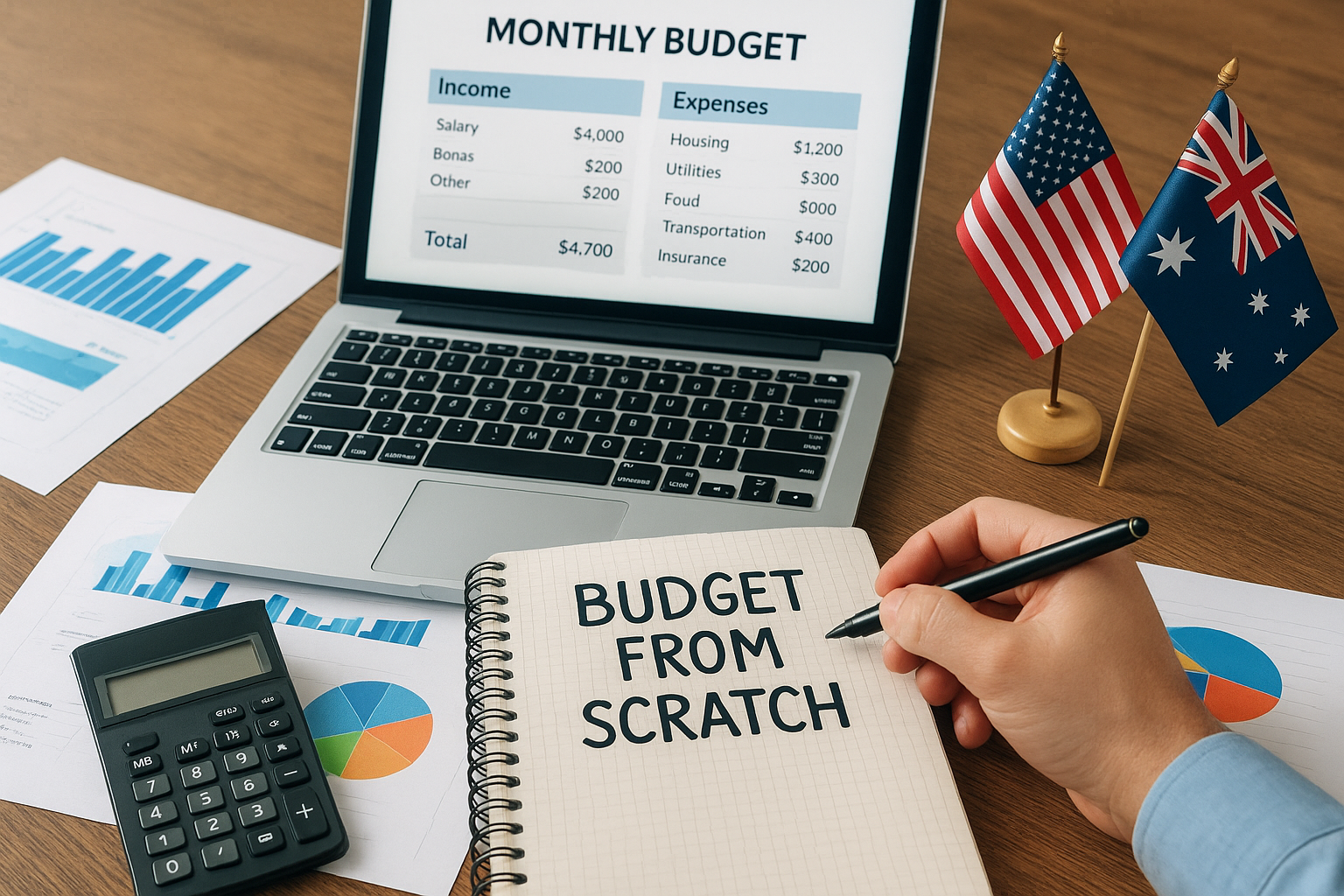Starting your budget from scratch might feel daunting—but it’s your first leap toward financial clarity and control. Whether you’re across the U.S. or in Australia, you can build a meaningful plan that suits 2025’s economic realities.
You’ll learn how to assess your income, set goals, choose tools, and build a lasting budget foundation. Let’s get into your budget from scratch journey!
What “budget from scratch” means in 2025 (US & Australia)
“Starting from scratch” means beginning without preconceived allocations—building your plan based solely on your real numbers, goals, and context. In 2025, moderate inflation and fluctuating interest rates make this fresh-start approach vital—giving you space to add a 3–5% buffer for essentials like groceries, housing, and utilities.
1 — Know your net income (after tax)
- U.S.: Look at your take-home pay—after taxes, benefits, 401(k), health insurance. This is your real foundation.
- Australia: Use your net salary—after income tax, Medicare levy, and super contributions—to map spending.
This ensures your budget from scratch is grounded in what actually lands in your account.
2 — Track 30 days of spending (fast method)
Review your bank and card statements for one month. Categorize every item—groceries, subscriptions, one-offs—so you see where your money goes. This immediate view is the fuel for your budget from scratch setup.
3 — Categorize: fixed, variable, debt, and irregular bills
Group your spending into:
- Fixed (rent, loan payments)
- Variable (food, gas, utilities)
- Debt (credit cards, student loans)
- Irregular/annual (insurance, vehicle registration, holiday gifts)
This lets you spot leaks and seasonal costs you might otherwise ignore.
4 — Pick a budgeting method that fits you
Here are top options to consider:
- 50/30/20 rule: 50 % needs / 30 % wants / 20 % savings & debt
- Zero-based budget: Every dollar gets a purpose until zero remains
- Envelope/cash-stuffing: Physically divide funds into categories—great for anchoring habits.
- 75/15/10 rule: 75 % needs / 15 % long-term investments / 10 % short-term savings
Pick what aligns with your style—rigid trackers or flexible themes.
5 — Set targets that matter
- Build an emergency fund: Start small, aim for 3–6 months of essential costs—crucial in 2025, especially amid shifting rate environments.
- Tackle debt: Choose either the snowball (small balances first) or avalanche (highest interest first).
- Launch sinking funds: For irregular costs—holidays, insurance, school, repairs.
These goals tie your budget from scratch to real-life outcomes.
6 — Build your first monthly plan
Create a basic table—columns for income, fixed, variable, savings/debt. Insert actual numbers and assign categories. Use example percentages for both the U.S. and AU to guide you toward a working budget from scratch.
7 — Automate and choose your tools
- U.S.: Use bank bill pay, paycheck splits, or budgeting apps.
- Australia: Visit Moneysmart’s Budget Planner for free templates and calculators.
Automation = consistency without effort.
8 — Weekly check-ins & monthly review
Schedule quick check-ins to track progress. Each month, compare actual spending to your plan. Tweak as life changes—salary changes, new goals, or unexpected costs. This keeps your budget from scratch alive, not static.
2025 watch-outs
- U.S.: Mortgage rates may drop—but savings yields might, too.
- Australia: Keep an eye on super balance, fees, and contribution timing.
Common mistakes & quick fixes
- Over-complication: Stay simple so you’ll actually follow it.
- Forgetting annual costs: Use sinking funds or add 1/12 cost monthly.
- Skipping buffers: The 2025 economy demands extra cushion.
Printable checklist to start today
- Know your net income
- Track one month of spending
- Categorize expenses
- Choose your budgeting method
- Set emergency, debt, and savings goals
- Create your first plan
- Automate income & savings
- Check weekly, review monthly
- Adjust for unexpected changes
- Add a buffer of ~3–5 % to essentials
Your first surplus starts this month
Starting a budget from scratch isn’t just a task—it’s your empowershift. By focusing on real numbers, clear goals, and simple tools, you’re not just budgeting—you’re building financial resilience. Your first surplus could come as early as this month. Let’s make it the start of your financial future.
